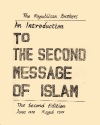Quran: The Meccan and The Medinese Texts
Going back to Quran it can be shown that Quranic texts fall into two distinct, though not mutually exclusive, classes: the Meccan texts which were revealed at Mecca and the Medinese texts which were revealed at Medina. This division of Quranic texts into Meccan and Medinese texts has a very important significance which stems not from the difference between the places of revelation, but rather from the difference in the levels to which the two classes addressed themselves. A slight digression into the history of the revelation of the Quran may clarify the point.
For thirteen years, Quran continued to be revealed to the Prophet Muhammad at Mecca. It enjoined him to call to the way of his Lord with wisdom, and good admonition, and to dispute with men in the better way because there was no compulsion in religion. It also enjoined him to preach the equality of men, and women, in all walks of life. Soon, the new religion began to draw adherents from all sections of the community, particularly from amongst the ranks of slaves and the oppressed classes of Mecca. That alarmed the Meccan religious and ruling circles who feared that their economic and political interests were being jeopardized. That feeling of fear was betrayed in such statements like “Muhammad is corrupting our pages against us ...” But those circles tried to masquerade that fear in religious disguise and waged, in the name of defending the religion of the fathers, an unholy campaign of terror against the followers of Islam. In that campaign they resorted to every available means of torture to force the Muslims to back into idolatry and exploitation. But that was not the whole story, for that campaign was escalated until it culminated in the plot against the life of the Prophet Muhammad himself who was forced to emigrate to Medina.
The treatment received by the Muslims at the hands of the Meccan ruling and religious circles, and their plot to assassinate the Prophet, amply demonstrated the inability of most men, at that time, to respond, intelligently, to the peaceful call to a more progressive and enlightened way of life. As a result, when the Prophet settled in Medina, the grand Meccan texts which established the fundamental human rights, catered for the equality of men and women, in all fields, and paved the way for every individual to attain absolute individual freedom, were repealed and the Medinese texts began to be revealed.
The Medinese texts appointed the Prophet as direct guardian over men who failed to handle their affairs successfully. Furthermore, the Prophet and the Muslims were, in the first place enjoined, in the Medinese texts, to fight in self-defense, a thing that was not catered in the Meccan phase. Then, that order to fight in self-defense was extended by the sword. That, of course was a direct consequence of the failure of most men at the time to rise, by persuasion and illumination to the required standard. The order to spread Islam by the sword meant that men were no longer treated as equals in the Medinese texts.
Now, if we come to the social plane we also find that men and women were no longer treated as equals. Indeed the Medinese texts put men in charge of women for reasons specified in these texts. Similarly, when we come to the political and economic planes we also find that equality in the Meccan texts had given way to inequality in the Medinese texts.
Thus it is very clear that the Medinese texts which were a great leap forward by the standard prevailing during the time of their revelation, were less superior in comparison with the Meccan texts which catered for the fundamental freedoms and treated men and women as equals before the law and in all walks of life. From this it is fair to conclude that the division of the Quran into Meccan and Medinese texts is a fundamental one, because the Meccan texts are the fundamental, original texts while the Medinese texts are the transitional texts revealed to pave the way for the return of the Meccan texts and to organize society in the period of transition.
Indeed, on this division of Quranic texts, into Meccan and Medinese, is based the most radical statement in the history of Islamic thought, namely, that Islam as revealed in the Quran is not one but two messages, the first and second, which are respectively based on the Medinese and the Meccan texts.

